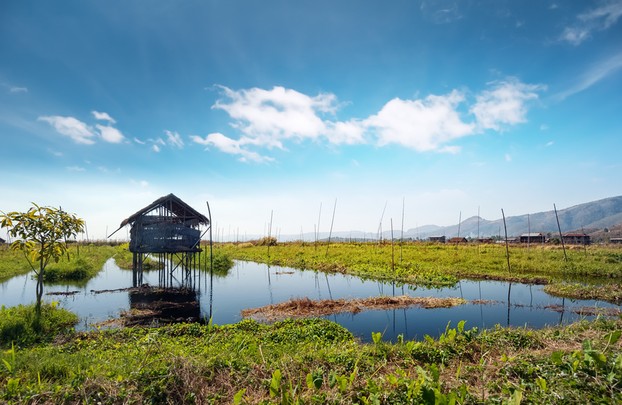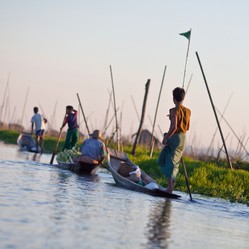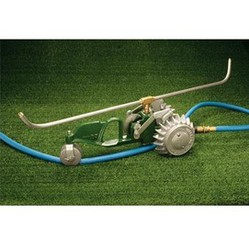Imagine that you dwelt in a land prone to flooding, or that there were land pressures that meant that you had no access to agricultural land, but you needed it. The solution is to grow on floating rafts made of vegetation. This technology is very ancient. At In Le Lake in Myanmar the locals dwell on the shore, but makes rafts out of plentiful weeds to which they sail out to cultivate their crops. As the lake rises when it rains, the gardens rise with the water, and so never flood. The simple houses can be flooded, but the food supply remains safe. The advantage is that as the lake is an enclosed space the rafts never drift far, and they can be tethered to long ropes and given markers so that families know whose raft is whose. This technique of tethering is used in Mexico.
Bangla Desh, a flood-prone land, is taking an interest. Many peasants have their land flooded and their crop destroyed by massive floods surging down from the deforested Himalayas, but now peasants in some areas are being encouraged to design floating, flood proof gardens. These are particularly suitable for areas such as lake sides where currents are not likely to sweep away the garden. Bangla Deshis are encouraged to keep fish in wire cages, so that if their fish farms flood their stock does not wash away.
The charity,Practical Action, advocates intermediate technology, which is half way between low technology, which impoverished communities possess and which keeps the poor impoverished, and high technology, which cannot easily be installed or maintained in many communities. Intermediate technology uses local knowledge, skills, and resources to achieve its goals, and it empowers communities and individuals, particularly marginal or oppressed groups, rather than large companies. The floating gardens of Bangla Desh have been advocated by Practical Action and have particularly empowered women, giving them the ability to own some productive land.
In fact, floating gardens have a long history. They are natural occurrences which arise when vegetation mats at lake sides break away from the shore. In Britain they probably occurred when we had more lakes, and when lake shores were not as tidy as they are now. In age when many Britons dwelt in Crannogs, villages built on piles in the lake, floating islands were probably common, though there is no evidence of vegetable growing on them, but such evidence would soon have disappeared,so absence of evidence is not evidence of absence. In Lake Titicaca Amerindians have long dwelt on floating islands, which were places where they felt safe from raiders.







 Pilgrimage. A reviewon 06/15/2025
Pilgrimage. A reviewon 06/15/2025
 Leo the Fourteenthon 05/09/2025
Leo the Fourteenthon 05/09/2025
 The Melsonby Hoardon 03/25/2025
The Melsonby Hoardon 03/25/2025



Comments
A long time ago. You would need to go back to the stone age for a more lacustrine landscape in Britain. But there were until recent years more wetlands.
The fourth paragraph to the first subheading, Flood problems, advises us that "In Britain they probably occurred when we had more lakes, and when lake shores were not as tidy as they are now."
Up until when did the British Isles have more lakes? And what made them go missing -- ;-D --?
In Britain, which has about twenty per cent of its land prone to flooding there is a big debate about how to respond to the waters, and this debate is becoming urgent as "once in a thousand years" flood events happen annually. We are beginning to think that it is easier to work with the waters rather than against them.
What a great idea. We certainly have lots of flooding around rivers here in the U.S.
There is a suggestion that Atlantis was a city on the Spanish coast destroyed by tsunami. Personally, I think that the similarities in the Asian and American gardens are explained by people addressing in conditions common to both Asian and America.
frankbeswick, The distances between the American and Asian gardens suggests to me that evidence of similar gardening styles may be found elsewhere, more or less anciently. Supposedly, Atlantis, whose description and black and red coloration make me think of Tenochtitlán, was famous for floating, hanging gardens. If true, the continuation can be seen as close as the chinampas and as far away as Lake Titicaca.
Your son's experiences in Le lake, just as those in the Andes, are fascinating!
Floating gardens are used in communities which use traditional methods,such as manure and compost, so I have not heard of fertilizer being used, though it surely could be. If fertilizer were used its fate would be: either to be taken up into the plant; or leached into the lake, where it would be absorbed by the weed that ultimately becomes the floating garden; or stays in the reed mat , which is then composted.
Hydroponic gardens should be self-contained systems, so any fertilizer in the water should stay within the system and be re-used. Moreover, as hydroponic systems are computerized to control fertilizer inputs, there should in theory be no waste to be released. In theory! Reality is often different from what we want it to be.
I would also think fertilizer is unused, especially with it being immediate to run off into the pond or lake. Is this coming about with hydroponic gardens which may not be quite the same, but do draw from water?
Another advantage is that land based pests cannot gain access to a floating island, and that helps gardeners.
My son Peter, who runs a non-profit travel blog, visited In Le lake and loved it. You can find it on www.backpackingbez.com